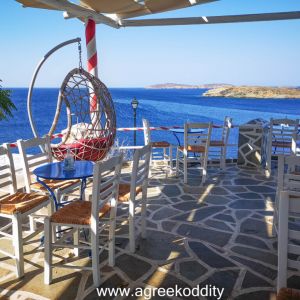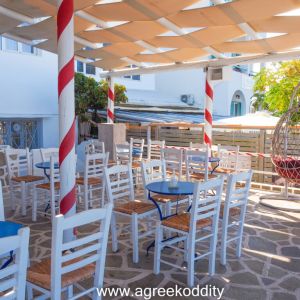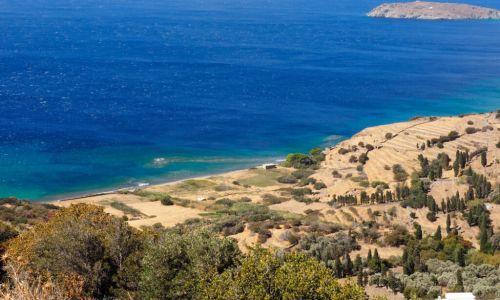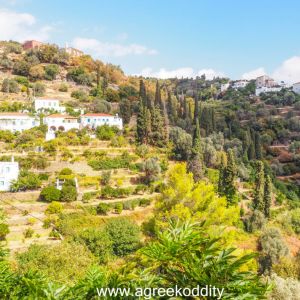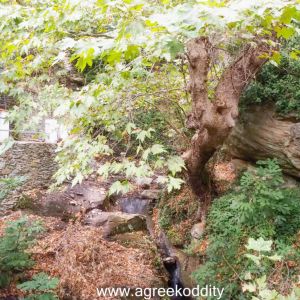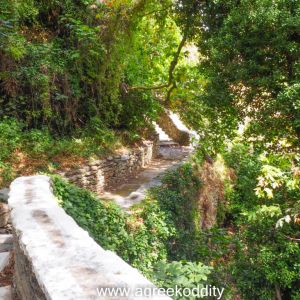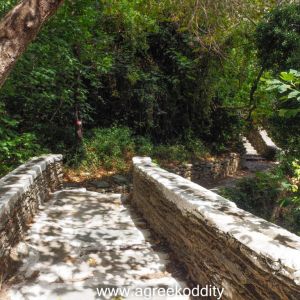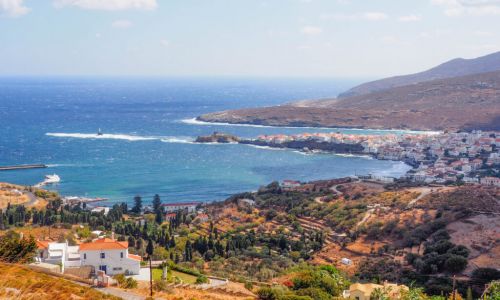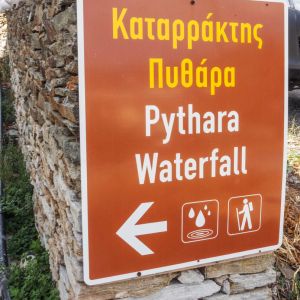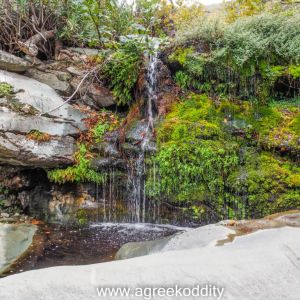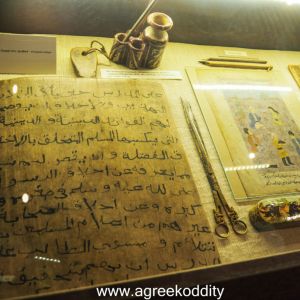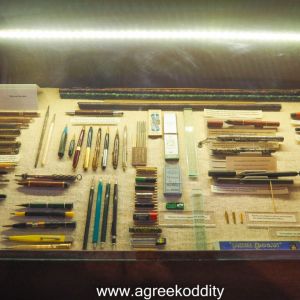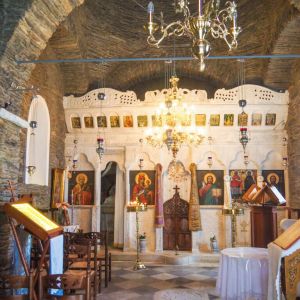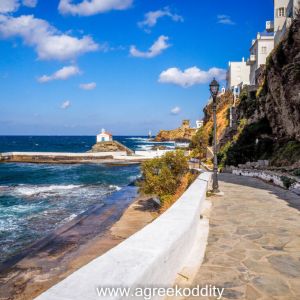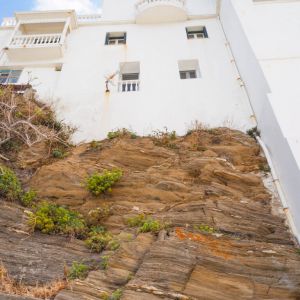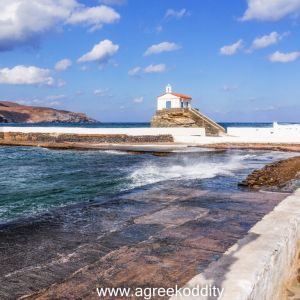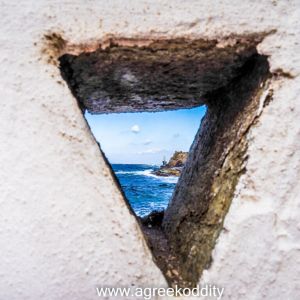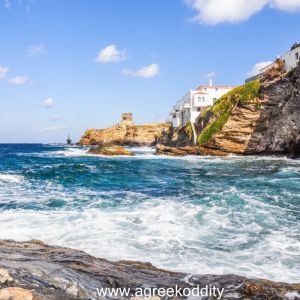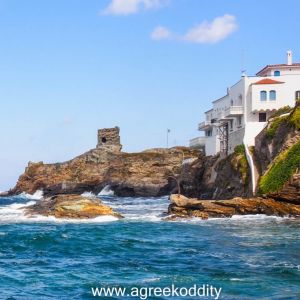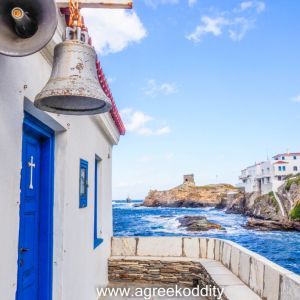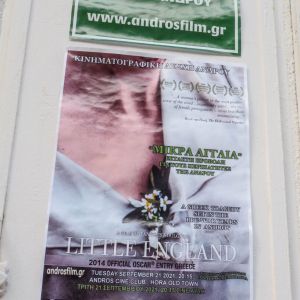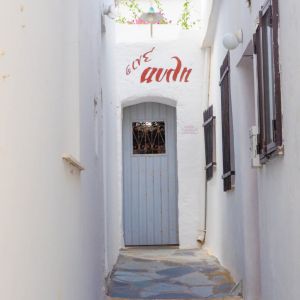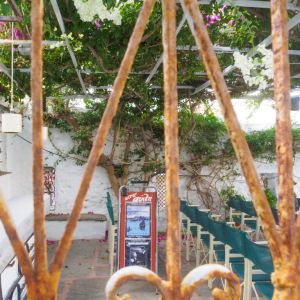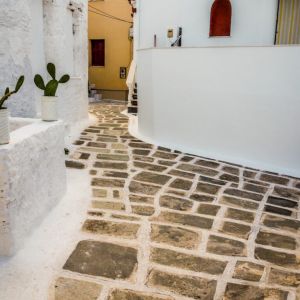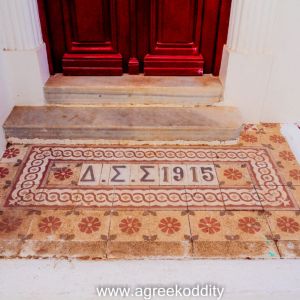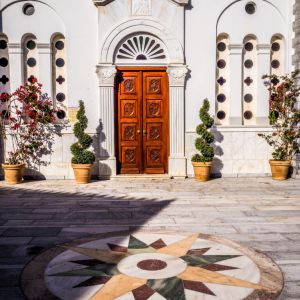A Whistle Stop Tour of Andros, Connections and Lateral Flow!
I’m really looking forward to my guided tour of Andros – albeit the truncated, half day version.
First things first, breakfast. There are so many choices of where to eat in Batsi but I walk into the centre and up the road out of the town. As soon as the road begins to climb, there is a little cafe called Loukou Bomb. It has a few tables and chairs outside plus a sizeable terrace overlooking the bay. This looks perfect!
Up on the terrace I placed my order for breakfast – Greek yoghurt with fruit and nuts and of course a pot of tea. Oh – and it didn’t stop there! I also ordered the cooked breakfast and by the way those aren’t carrots on the plate – they are sliced sausages! Well I’m going to need my energy for the island tour!
Conscious of time I head to VLM’s office back in the centre of the town and at the back of the beach.
I’m early – I’m always early for everything. However, Savvas is late. Adamantia explains to me that Savvas is dropping off a group of German hikers to a location up in the hills of Andros and he is having some ‘problems’. Anyway, this gives Adamantia time to chat. She tells me that she is at the University of Athens studying Maritime studies. She works at VLM during her vacation and she is due to go back soon. Further into the conversation we discover that we have a friend in common. Adriana is a colleague and friend of my husbands for many years. When she heard that I was coming to Andros she told me to go and say hello to her uncle who owns Capriocchio Bar located right at the end of the bay, overlooking the beach. Not only that her father has a taverna a couple of miles inland in a village called Katakilos.
When I mentioned that I have a friend who’s family is from Andros, Adamantia exclaimed “Nonie!” Yes – Adriana known as Nonie to her friends and family is also a friend of Adamantia! World! Small! What!
Time passed and an hour and a half later than expected, Savvas arrives – a little flustered – muttering that the Germans couldn’t decide where to start their walk. Anyway, I’m glad he was late otherwise I may not have discovered that I had a friend in common with Adamantia.
Before we head to the car I tell Savvas that whatever happens today, I must get a lateral flow test in Chora before the testing centre closes. No problem!
We head out of Batsi and up along the coastal road on the Western side of the island. Before heading inland, Savvas stops the car in Paleopolis – or rather modern Paleopolis. From here he points out to the coastline below and tells me that submerged below the waters is the ancient city of Paleopolis. Beyond the clusters of Italian Cyprus trees and heavily terraced agricultural land I can make out the outlines of submerged structures in the water. This sunken city is known to have had temples and an agora with a large market place. There is a nearby museum which documents the history of this archaeological site but we don’t have time to stop and visit it as we are on a tight timescale. (even tighter now)
Back in the car, we begin to traverse the island in an Easterly direction to the village of Menites which is located on Mount Petalos half way between Paleopolis and Chora. Here the island really does begin to appear greener and more lush. There are Italian Cyprus’s in abundance! Savvas tells me that if you look at the map of Evia, Andros and Tinos you will see that they are like jigsaw pieces that once used to fit together. After the tectonic plates shifted, the pieces separated and the green part of Andros takes its characteristics from its matching piece on Evia. I found that rather poetic!
Menites is like a little oasis of calm and tranquillity. The water from the springs trickle out of the mouths of marble lion heads and moss, algae and ferns sprout from every nook and cranny. If it wasn’t for the smell of heat on fig trees, if you squinted you could swear that you were in Wales. The village is built among walnut and plane trees which offer dappled shade and a spongy carpet of fallen leaves under foot.
We go for a slow stroll around the village which really does have a unique feel. I would love to come back to Andros and stay right here! Menites is a walker’s paradise and many of the walking trails begin here.
The next destination is the Pythara waterfall. The road takes us slightly North of Chora and we stop for another photo opportunity along the way.
Although a little hazy out at sea, from here we have the perfect vantage point in which to view Chora from above. Here you can see the cluster of mansion houses built along the length of the peninsula. At the tip of the peninsula is what remains of the Venetian Kato Kastro. Following the line along to the left of the Kastro is the Tourlitis Lighthouse which sits out at sea looking rather desolate and alone. The original lighthouse, along with the Kastro was destroyed during World War 2. Savvas tells me that the modern version was built by a rich oil tycoon and which was dedicated to his daughter. Savvas has a look of disdain on his face as he tells me this. I get the sense that his disapproves. Apparently this lighthouse was Greece’s first automated lighthouse, built (or rather re-built) in the early 1990’s. At least it does serve some purpose rather than solely being a vanity project.
Shortly we arrive in Apoikia for the Pythara Waterfall. After parking up we take a stroll past rural homesteads along a path that gradually begins to narrow. I’ve visited quite a number of waterfalls in Greece over the years and I know that many people visit with the expectation of seeing something really impactful. However, I know that the power of the falls will depend on the the time of year and the amount of rainfall during the preceding period. What I’m saying is that I’m not expecting Niagra.
It isn’t Niagra, but the falls here and the surrounding area is beautiful. Very calm with the sound of falling water into the pond and it’s obviously a very bio-diverse area. Savvas dares me to jump across the large stones to the other side of the pond – which of course I do. Mid jump he tells me to watch out for the water snakes! As I crank my head mid air to throw him a look, he laughs and tells me that they aren’t dangerous. Someone’s going to get sent to the naughty step!
Further into Apoikia we have one more stop before heading off to Chora – the Monastery of St Irene. Before we arrived Savvas told me the history of the monastery which is outline here on the monastery’s website.
History
The monastery of Saint Irene was founded in 1780 at Archontas in the village of Apoikia by the Spiridou brothers, both of whom were monks.At that time it was a nunnery, but in 1834 it was abandoned, due to King Otto’s Royal Degree which demanded the dissolution of the orthodox monasteries, which numbered about 1000 in Greece, with a smalls number of monks or nuns and the confiscation of their properties. Gradually, the buildings around the church collapsed, although the church remained in good condition.In 2006, Captain Eleftherios Polemis bought the field which included the ruins of the monastery. He and his family renovated the buildings around the church and did maintenance work inside the church, remaining true to the previous architectural form. The renovation took 10 years.Nowadays, the monastery plays a big role in the community. It holds summer camps for children, many of whom are orphans.
Furthermore, throughout the whole year it houses the following exhibitions:1. History of writing (Kairis Collection)2. Traditional musical instruments3. Collection of stones, minerals & fossils (Spiros Mpellas collection)4. Elli Mandaraka – Stamatiadou & Flora of Andros5. Collection “Blacksmiths, handicrafts” (collection of Michael Kairis)
Holy Monastery of St Irene of Andros
The most interesting thing for me was the work that is currently being done for underprivileged children. I can see that Savvas is very proud of the work that the late Captain Polemis has undertaken – a real local hero.
There is already a guided tour about to begin so Savvas introduces me to Maria who leads the tour around the monastery. The various collections really appeal to my own obsession with collections – oh heck – there are door knockers too!
It is now early afternoon and we know that the Covid testing centre in Chora closes at 3pm so we head straight there with Savvas driving like a bat out of hell. Sorry, wrong reference considering that we’ve just a monastery!
I must admit I haven’t been looking forward to this test. I’ve kept myself well isolated and have been particularly cautious during the pandemic which felt quite far removed from my daily life. It was only after researching that Covid swabs are taken from the nose that I decided to book this trip. Had it been a throat swab I wouldn’t have been able to do it. Nonetheless a small price to pay to be able to travel again.
Savvas drops me off outside the entrance. There is already someone at the reception desk so I wait outside until it’s my turn. The whole process is very fast and pain free. For the cost of 10€ I receive my negative test in an envelope. All I have to do later is complete the return Passenger Locator Form and then I’m ready to go home. Not that I want to think of that yet.
Savvas drives us to the edge of the town where we park and walk. Naturally the walk starts on the main marbled street that leads down the length of the peninsula. But Savvas is a man ‘in the know’ and diverts us down an alleyway to the left. It brings us out on the Western side of the peninsula and towards the Mother of Lord Thalassini Holy Chapel set out on it’s own tiny peninsula. Above us you can see how some of the mansion houses have been built on the edge of the rock. The wind has really picked up today and the waves on this side of the island are ferocious, yet very atmospheric. There is an interesting vista at every turn – the benefit of taking a tour with a local guide!
I know we are drawing close to the end of the tour and Savvas tells me I have some time to roam Chora on my own for an hour. On the way back to the main street Savvas points out the Andros Cinema Club. It is run by volunteers and aims to bring additional cultural experiences to the local residents all year round. By the way if you haven’t yet seen the film Little England directed by Pantelis Voulgaris I highly recommend it.
Restraining myself from going on another door knocker or chimney pot hunt, I spend the next hour exploring a couple of alleyways I’d missed last time. A short but sweet tour of Andros but it has certainly given me the thirst to come back for a third visit only not in another 20+ years time.



